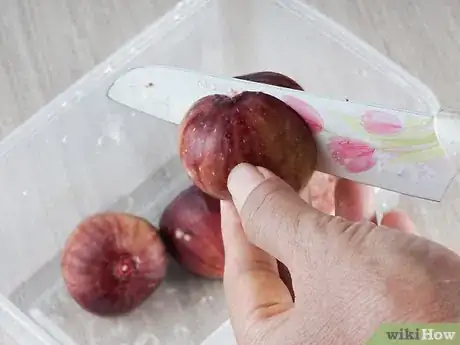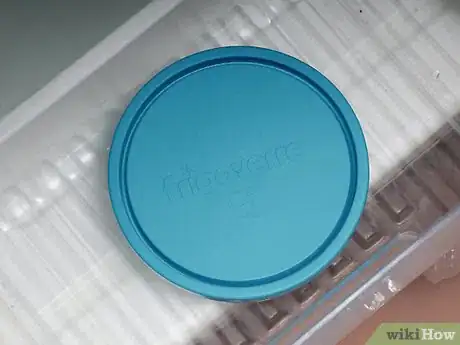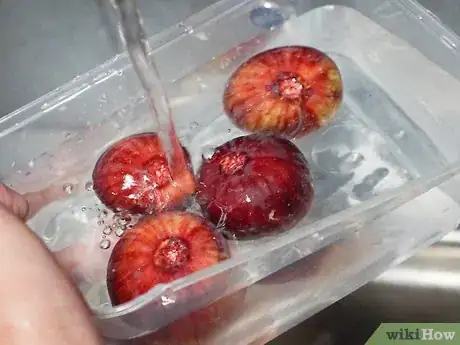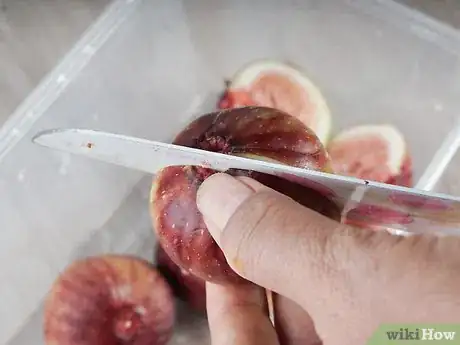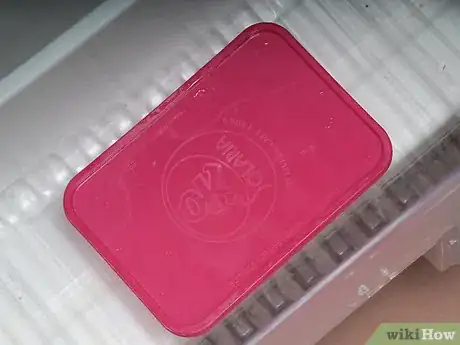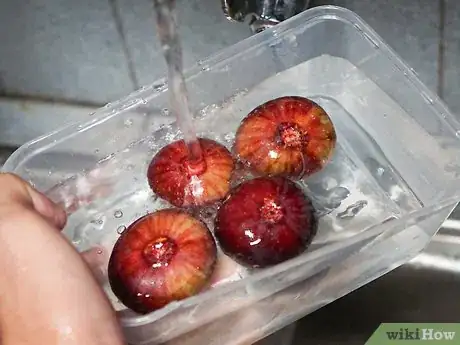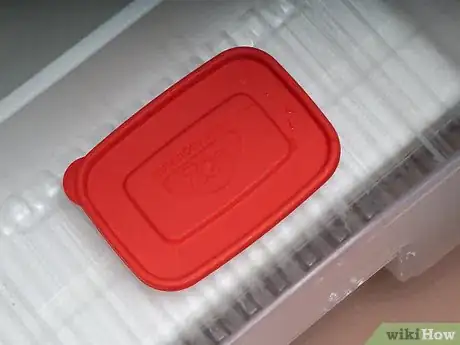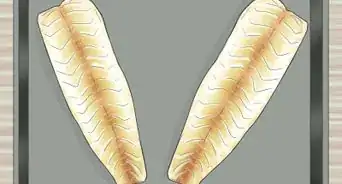This article was co-authored by wikiHow staff writer, Sophia Latorre. Sophia Latorre is a Content Manager on the wikiHow team. Before joining wikiHow, Sophia worked as a technical editor and was published in six International Energy Agency (IEA) Wind Annual Reports. Now, she writes, edits, and reviews articles for the wikiHow Content Team, working to make the content as helpful as possible for readers worldwide. Sophia holds a BA in English from Colorado State University.
wikiHow marks an article as reader-approved once it receives enough positive feedback. This article received 21 testimonials and 86% of readers who voted found it helpful, earning it our reader-approved status.
This article has been viewed 375,196 times.
Learn more...
Contrary to popular belief, a fig isn't actually a fruit—it's a collection of dried flowers! Figs are high in iron, calcium, and potassium, and have more fiber than most fruits and vegetables. Drying figs preserves their sweet taste and allows you to store them for months. You can dry figs in the sunshine, in the oven, or in a dehydrator.
Steps
Drying Figs in the Sun
-
1Rinse fully ripe figs. The best indication that a fig is fully ripe is when it falls to the ground. Rinse the figs with cool water to remove dirt and other debris, then pat them dry with a dishcloth or paper towel.
-
2Cut the figs in half. Use a paring knife to cut the figs in half from stem to tip on a cutting board. Cutting the figs in half will help them dry more quickly.Advertisement
-
3Lay them on a wire or wooden rack covered with cheesecloth. Put a layer of cheesecloth on top of any wooden or wire rack, such as those intended for cooling or dehydrating. In order to dry properly, the figs need airflow from above and below, so don't use a solid surface like a baking sheet. Place the figs cut-side up on the cheesecloth.
- Alternatively, you could put whole figs on wooden skewers and hang them in the sun, using clothespins to attach the skewers to branches or to a clothesline.[1]
-
4Cover the figs with cheesecloth. This will protect them from insects as they dry. Tuck the cheesecloth tightly around the drying rack, securing it with tape if necessary, to make sure it won't come loose.[2]
- If you hung up your figs instead, you won't be able to protect them with the cheesecloth.
-
5Place the rack in full sunlight during the day. This method works best when it is very dry and hot outside. Don't place the figs in the shade, or they won't dry as quickly and may spoil before they're properly preserved. You'll need to bring them in each evening so they don't get spoiled by dew.
-
6Return the figs to the sun for 2 to 3 days. Each morning, turn the figs over so they dry evenly on all sides and then place them back outside in the sunlight. The figs are ready when the outside feels leathery and no juice can be seen on the inside when squeezed.
- If the figs remain a little sticky, you can finish them in the oven.
-
7Store the dried figs in airtight containers in the fridge or freezer. Tupperware or Ziploc bags are both options for storing your dried figs. They'll last several months in the fridge, or up to 3 years in the freezer.
Using the Oven
-
1Preheat your oven to 140° F (60° C). This should be the lowest setting your oven has, which is necessary to dry the figs at a low, even temperature. Drying them at a higher temperature would result in cooked figs.[3]
- If your oven doesn't heat to such a low temperature, set it at the lowest possible temperature and keep the oven door partially open.
-
2Rinse the figs thoroughly with water. Carefully trim away the stems as well as any damaged parts and pat them dry with a paper towel or dishcloth.[4]
-
3Cut the figs in half. Use a paring knife to slice the figs from stem to tip, lengthwise, on a cutting board. If they are particularly large, cut them in quarters.[5]
-
4Lay them cut-side-up on an oven-safe rack. Be sure to use a rack with ventilation holes, so that the figs dry from below and above. Using a regular baking pan will result in figs that don't dry evenly.[6]
-
5Put the figs in the oven for up to 36 hours. Prop the oven door open slightly to allow the moisture to escape and prevent the figs from getting too hot and cooking instead of drying. If you don't want to leave the oven on continuously, you can turn it off halfway through, then turn it back on if necessary. Be sure to turn the figs occasionally during the drying process.[7]
-
6Allow the figs to cool completely before storing them. The figs are done drying when the outsides are leathery and no juice can be seen on the inside when you split one open. Remove them from the oven and let them cool completely before placing them in airtight containers, like Ziploc bags.[8]
-
7Put airtight containers full of dried figs in the fridge or freezer. You can freeze figs for up to 3 years. Or, you can keep them in the fridge for several months.
Dehydrating Figs
-
1Turn the dehydrator to the fruit setting. If your dehydrator doesn't have a fruit setting, turn it 135° F (57° C).[9]
-
2Rinse the figs and cut them in quarters. Rinse the figs in cool water, then dry them with a dishcloth. Use a paring knife to remove the stems and cut the figs in quarters on a cutting board.[10]
-
3Place them skin-side-down on the dehydrator trays. Make sure to leave some room in between the fig pieces so air can circulate around them.[11]
-
4Dehydrate them for 6-8 hours. The amount of time will depend on the climate in your area as well as the size of the figs. Check them after 8 hours to see if they are dry to the touch, but still pliable and chewy. If so, they're done.[12]
-
5Remove the trays and allow the figs to cool. Once the figs are done, carefully remove the trays from the dehydrator and place them on a heat-resistant surface. Let them cool completely before storing them.[13]
-
6Store the dried figs in the fridge or freezer in airtight containers. Put the dried figs in Tupperware containers or Ziploc bags. They'll keep in the freezer for up to 3 years or in the fridge for several months.
Community Q&A
-
QuestionHow should you store dry figs?
 Community AnswerYou should store them in an airtight container and eat them as soon as possible.
Community AnswerYou should store them in an airtight container and eat them as soon as possible. -
QuestionCould I dry whole figs in a dehydrator?
 Community AnswerYes, but they will take longer to fully dry out.
Community AnswerYes, but they will take longer to fully dry out. -
QuestionI put some dried figs in a plastic bag and some of them have started to mold. What did I do wrong?
 Community AnswerIt's possible that you didn't dry them out right, or that there was some moisture in the bag that allowed them to mold. There might also be a small hole in the bag, or the bag may not have been sealed properly. Either way, you should throw them away.
Community AnswerIt's possible that you didn't dry them out right, or that there was some moisture in the bag that allowed them to mold. There might also be a small hole in the bag, or the bag may not have been sealed properly. Either way, you should throw them away.
Things You'll Need
- Figs
- Water
- Dishcloth
- Cutting board
- Knife
- Drying rack
- Cheesecloth
- Airtight containers
References
- ↑ https://delishably.com/fruits/drying-figs-in-the-sun
- ↑ http://www.countryfarm-lifestyles.com/drying-fruit.html
- ↑ http://tipnut.com/dry-figs/
- ↑ http://tipnut.com/dry-figs/
- ↑ http://tipnut.com/dry-figs/
- ↑ http://tipnut.com/dry-figs/
- ↑ http://tipnut.com/dry-figs/
- ↑ http://tipnut.com/dry-figs/
- ↑ https://www.amodernhomestead.com/dehydrate-fresh-figs/
About This Article
To dry figs, start by cutting them in half with a knife. Then, place the figs on an oven-safe rack with ventilation holes so the cut sides are facing up. Next, set your oven to the lowest temperature setting and put the figs inside of it. Let the figs dry in the oven with the door propped open for up to 36 hours. Once the figs are dry, let them cool completely before serving or storing them for later. If you want to learn how to dry your figs in the sun, keep reading the article!

